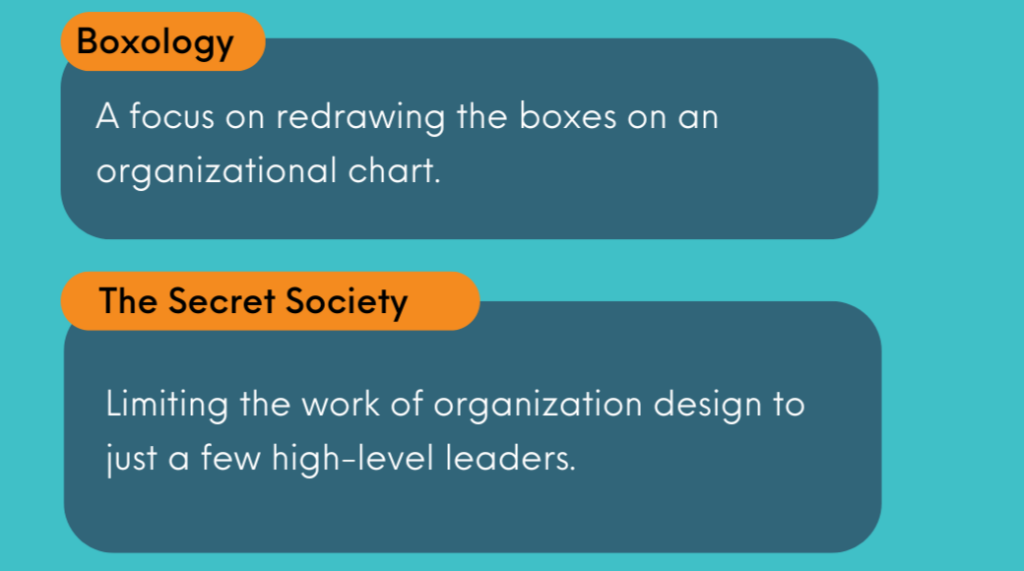Here is the scenario: Your leaders continue to talk about how siloed their teams are, they don’t have the information they need to do their jobs, and that multiple people on multiple teams seem to be doing the same work. So, you pull a few key leaders into your office and whiteboard a new org chart. Sound familiar?
Fortunately, as you’ve read in AlignOrg’s book, Mastering the Cube, there is a name for the work you’ve just done. It’s called Boxology and The Secret Society. You pause and tell the group that instead, you must align all of the systems—not just the lines and boxes. And to do it well, you must co-create.

Structure: Just One Component of Org Design
I cannot begin to count the number of times that, as an HR business partner, I walked into a leader’s office and saw a redrawn picture of their organization structure on their whiteboard. Their request to me: how soon can we implement this and when can we communicate it? Leaders often believe that simply redrawing boxes will solve the issues their teams are experiencing. What some leaders fail to realize is that structure is just one component of organizational design.
When we approach org design through the myopic lens of org structure, we miss many other important factors. For instance, is the leader experiencing issues because the right work isn’t grouped together? Are strategic items being deprioritized because the work is muddled down by necessary activities? Perhaps information flow isn’t occurring as it should because there are issues with how the leadership team works together (or doesn’t).
At AlignOrg, we approach organizational design by looking at the system as a whole, not just as the sum of its parts. To fully understand the pain points and solutions, we need to consider how the parts work together. We do this in a design session by working through a series of questions. We facilitate a rich dialogue with the experts themselves (YOU) to make choices across the whole system. As those choices are made, we also ensure leaders understand how each choice impacts the rest of the system.
What if Structure Isn’t the Problem?
I was working with a global commercial team not long ago. They were determined to make some radical changes to their structure. After much discussion about the strategy and the work of the team, we iterated on several structural options. We found that none of the options we explored had better upsides and fewer downsides than the structure they were operating in today. They felt defeated, after all, “If nothing changes, nothing will change!”
I then asked, “What if structure isn’t the problem?” It took a few minutes for this question to sink in. After all, why would we waste days bringing a global team together to NOT change the structure? After all, aren’t we doing org design?
And that is when it clicked for them: there are many things we can change in the system without changing the structure. As they were debating what work belonged regionally versus centrally, the reporting structure didn’t have to change to shift key work activities to be driven differently. What did have to change were processes, linkages, and how some leaders needed to work together differently in the future. We had to determine where work would be standardized and where it shouldn’t be. Leaders debated where they were and they weren’t willing to give up control of certain work.
The Challenge of Thinking Beyond Structure
Implementing this type of change often proves more challenging. There are no boxes and lines to show in a town hall; instead there are behaviors and ways of working that need to be changed. People may need to pick up work that someone else is doing or give up work at which they excel. It’s not a quick update to the HRIS on go live. Instead, it’s an evolution of moving work, creating standard processes, and changing how we work together. It’s hard work—and maybe that is why leaders jump to the tangible solutions of changing the boxes and lines.
Before you consider making an org structure change, take the time to step back and evaluate your team across the whole system (or around the sides of the cube). You might just find that there are plenty of culprits for inefficiencies and frustrations you and your team are experiencing. Structure might not be the problem after all.
If you find yourself with a Secret Society building Boxology on your whiteboard, we’d love to partner with you and your team to uncover misalignments in your organization!





